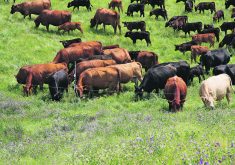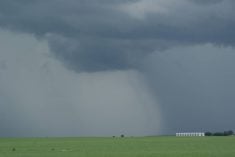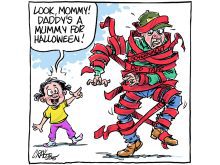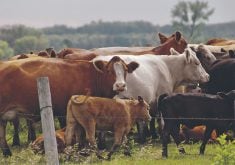To the Editor:
(Copy of letter to agriculture minister Ralph Goodale:) As a grain farmer of northwestern Alberta I was delighted and relieved to hear your pronouncement that Alberta would not be allowed to opt out of CWB marketing jurisdiction.
The validity of Alberta Agriculture’s recent plebiscite is certainly suspect given the wording and given the employment of a telemarketing firm to “pull the vote.” Two concerns I have are:
1) Were commercial feedlots issued ballots?
2) Did the telemarketing firm hired, using the Alberta Barley Growers membership list, do a balanced telephone poll or was it weighted more heavily towards farmers of southern Alberta?
Read Also

Farmer ownership cannot be seen as a guarantee for success
It’s a powerful movement when people band together to form co-ops and credit unions, but member ownership is no guarantee of success.
Many farmers I spoke to in the North Grande Prairie region where I farm had not heard about the plebiscite and did not vote.
In its recent publication, winter 1995 of Barley Country, the Alberta Barley Commission states that the CWB as a class III crown corporation is not subject to the scrutiny of the Auditor General’s office. The accusation is that the CWB is not financially accountable. Some clarification is necessary.
Again let me compliment you and your department and all the CWB staff and Advisory Board members for doing a credible job on behalf of all farmers in spite of the howls of derision and unwarranted innuendoes even from my own MLA Walter Paszkowski.
Sadly he represents a misguided lot of self interested individuals who have forgotten that the western grain economy and their communities are built on cooperation, not indifference.
– K. Norman Dyck,
Debolt, Alta.
CWB history
To the Editor:
In 1935 the Dominion government set a voluntary wheat board which operated as such until 1943 when it became the sole marketing agent for wheat in Canada.
Another great asset to the producer, under this system price for grades etc. were established at the beginning of the year and an initial price was paid and at year end the profits were paid out as a final payment, (the first time ever that a stabilized price was established), equal to all, (one mile from the U.S. border or northern Sask.) same to all.
A prime example, of not so long ago, and those who got stung will well remember, when ECON were supposedly going to show up the grain trade,. When they were finally caught up with and shut down, of those who were involved at the time, some got part, some got none, but none got all of what should have been coming to them. That was the old open-market system in action. Wouldn’t the CWB have been nice at that time?
Later barley and oats were added to the CWB and took the anxiety out of the marketing of these grains. This service only costs three and one-half cents per bushel and is an envy to most of the world including the U.S.A. Our MPs would do well to work toward getting oilseeds and oats put back unto the Board, rather than suing and being critical of its every move.
They should also work toward organizing more boards to protect the farmers in the costs of production, like fuel costs, machinery and repair costs, etc.
A stabilized price should be established to protect the small farmer who is continually subsidizing the large ones in so many ways.
Also every producer car that is shipped is a nail in Pool’s coffin, although they like to have their facilities to handle the part cars for them. It is becoming more and more evident that they would like to use the facilities to mix off their grains for them.
Perhaps the shoe has got wet and is beginning to pinch like in the old days, eh!
Our MPs have a lot to be desired that is very evident. Under big money tycoon control.
– Joseph Hagyard,
Glenboro, Man.
Beware lenders
To the Editor:
“Won’t you come into my parlour” said the spider to the fly. In other words, beware of the money lender and his clever ways.
Have you noticed that whenever our Minister of Finance in Ottawa makes an attempt to control the deficit he has no difficulty in slashing funding to social programs to reach his goal, but is powerless to save by reducing the rate of interest on the debt by so much as a fraction of one percent?
Have you also noticed how his policy of restraint will cause some workers to be laid off while those kept on the payroll continue to receive the same unrealistic, inflated, union-dictated wage rate as before – the very thing which caused the problem in the first place?
This all goes to show to what extent we have allowed our nation to slip from being a democracy (if it ever was) into a demonocracy, ruled and controlled by a demonic and tyrannical force led by Mammon’s international loan sharks and greed driven unions.
Anyone growing up on a mortgaged farm in the 1920s and 1930s was well schooled in the evil of usury and the economic slavery it has to offer those lured into its web.
To cite my own family’s experience: It was 1918, optimism was riding high, the war was coming to an end, and grain prices had never been better. A mortgage was placed on a half section farm to build a house – it was calculated that two or three crops would see it paid off.
This however was not to be. A disastrous frost in July of that same year left only empty heads at harvest time. What followed was the post-war depression of the 1920s which got even worse in the 1930s.
The $3-a bushel-wheat of 1918 was now worth only 30 cents, yet the rate of interest on the mortgage showed no change. Not until another war came along was prosperity restored to the farm thus enabling the debt to be paid.
All throughout the 23-year life of the mortgage, money needed for growth had been siphoned off and lost forever in interest payments, leaving the farm in a sorry state of stagnation.
If there was one event in particular throughout those tough years that imprinted on our young minds the evil of usury, it was to see our parents each fall after harvest getting out Eaton’s catalogue to write out an order for winter clothing and other needs, only to have to cross off item after item simply because there was so little money left once the mortgage company had taken its pound of flesh.
Is it any wonder that my generation vowed we would never allow ourselves to fall prey to moneylenders the way our parents had?
Do we not recognize in the above a striking parallel with what we have allowed to take place on the national scene as billions of dollars desperately needed to fund capital works and social programs are being wasted and lost forever, poured down Mammon’s endless gullet in interest payouts, while the people groan under an intolerable tax burden unable to yield enough to satisfy the beast’s ravenous hunger?
The future of our nation and of our homes looks bleak indeed, unless something drastic is done, and done soon.
In the private sector whenever an individual or a company find they are hopelessly in debt there is a way out by declaring bankruptcy and settling with their creditors at a fraction of the indebtedness. There is no such easy way out for a nation however.
Should Canada, for example, default on her debt, the value of her currency would plummet overnight. Such is Mammon’s power.
Yet if all the nations of the world were to act together to outlaw the charging of interest (perhaps through the United Nations Organization), Mammon could be brought to his knees never to rise again.
With the curse of the beast lifted from mankind a new age of peace and plenty would dawn, such as the world had never before known.
No longer would men be able to pile up millions while others around them starved.
– Edward Whitlock,
Raymore, Sask.
Bus drivers
To the Editor:
Daryl Briscoe’s column in the Feb. 8 Western Producer is likely to send heads spinning and hearts fluttering among all of my fellow farmer/school bus drivers.
Unfortunately, as is true to a lot of rumors, the story gets changed considerably over the miles, i.e. from Regina to Daryl’s town. I live about a dozen miles from the Legislature, otherwise known as Red Square, so the rumors haven’t had as much chance to get altered before I hear them.
Actually, the plan goes like this. Instead of teachers taking a 10-percent pay cut, and the money instead going to the rural bus drivers, the hot tip is the rural school bus drivers will be fired and their pay given over to the teachers in the larger cities in the province.
The NDP knows through polling that their support among urban teachers has slipped to 96 percent so what better way to get their attention come election time than a healthy raise of 10 percent?
The thinking is that farmers who drive school buses are, in effect, getting a government handout and we all know what the NDP government thinks of handouts to farmers.
The rural kids will, of course, have to walk to school but hey, it builds character. And it will give them something to tell their grandchildren about, how “back in ’97 I had to walk 10 miles to school through blizzards and storms – you young’uns are wimps!”
At first they were only going to fire half the bus drivers so instead of starting my bus route at 6:50 a.m. each morning, I would have had to start at 4:30 a.m.
Then someone in cabinet, no names mentioned, said, “If they’re up that early, they might as well walk.”
There’s no word yet on when this will come about but I hope my job lasts until the end of this school year. That way, I’ll have enough money saved up to pay back my GRIP overpayment.
– Jim Johnson,
Regina, Sask.
Rail facts
To the Editor:
Two recent articles in the Western Producer attracted my attention, the first being the debate as to whether the government of Canada should sell the government-owned grain cars to the old-line railways or hand them over to the grain producers either by sale or as a gift, a point I wasn’t too clear on. My question is, if the farmers take possession by whatever price, has any thought been given as to who is going to stand the cost of maintaining these cars?
Strangely enough, the general public seems to think freight cars are like the battery-driven bunny – they just roll on and on. As a long-time employee of the CN car department, I can assure you such is not the case.
All first-class railways and fleet owners belong to what is known as the Association of American Railways and as such are subject to a standard costing of material and labor required to put any disabled car back on the road and every billing form contains the words “Bill Owner.” Should the farmers become the new owner of these cars, the CN or CP being in all likelihood the only outfits with the facilities and expertise to carry out the necessary repairs will only be too happy to “bill owners,” the new boys on the block.
In order to be in a position to pay these bills an association will have to be set up to levy a fee based on the tonnage shipped by each to cover a major disaster such as a derailment, which seems to have become a fairly common occurrence on the prairies this winter. It may be that handling lines are responsible for such mishaps, however every day repairs such as brake shoes, wheel change-outs, couplers, draft gears, etc., that are due to just wear and tear are not uncommon and carry a heavy price tag.
The main objective of farmer ownership seems to be that they would be in a position to dictate how the cars would be allotted to various shipping points. That may be true but I would be inclined to think since CN/CP still own the tracks and the motive power to move said cars they are still going to be in the driver’s seat.
The second point of interest concerns the Port of Churchill. A program carried on CTV’s W5 recently painted a much different picture than a couple of articles in the Western Producer. The TV program emphasized the extremely short shipping season and worst of all the 500 or 600 miles between The Pas and deep water.
Trains snaking their way through the muskeg at 20 or 30 miles an hour hardly looked like an attractive situation. It is said that over its length there are over 2,000 sink-holes which, to bring the line up to scratch, will require digging down to bed rock or at least a stable footing and refilling … Needless to say millions of dollars will be needed to carry out these improvements.
… Over the years if the CNR, with the backing of the government of Canada’s credit rating and political influence, could not bring itself to undertake such a daunting task then it would take a tremendous leap of faith to think that a private company would give it a second glance.
I am sorry I can’t put a more positive spin on these matters since today’s farmers are already faced with a host of problems beyond their control. However I have pointed out two situations where it might be well to look before you leap.
– Delbert Brock,
Sudbury, Ont.
Carbofuran-WWF
To the Editor:
In his recent column regarding carbofuran, Ed White insinuates that World Wildlife Fund has approached its campaign to ban this pesticide with callous disregard for farmers’ interests. Yes, we have been at the forefront of efforts to de-register this chemical because of its proven impact on a variety of wildlife, including the endangered Burrowing Owl, songbirds and waterfowl. No, we have never said that farmers should be able to “skip along merrily without it” – those are Mr. White’s words.
Carbofuran has been such a high priority for WWF because it is known to be one of the most highly toxic pesticides in current use, and also ranks as one of Canada’s top 10 insecticides in terms of sales.
Carbofuran is used over large acreages, for economically important pests (grasshoppers and flea beetles). All WWF’s materials and comments point to the availability of other pest-management options, including other registered pesticides, and non-chemical methods such as barrier and trap crops and resistant varieties, which can reduce the impact of pests.
Government regulators agree both that the impacts of carbofuran are unacceptable and that alternatives are available. As a result, carbofuran for grasshopper control has been banned as of this year, and the lower-concentration granular for canola has been conditionally registered while further studies confirm or deny its risk to wildlife. …
A quick factual correction as well: World Wildlife fund has never contended that granular carbofuran affects the Burrowing Owl since this formulation is not (generally) used in its southern prairie range.
But it does affect numerous migratory songbirds which land in canola country. It seems the object of the column was to infer conflict rather than convey information.
It would be ill-advised to assume that pesticides in current use are “safe” just because they are registered. While Burrowing Owls and other wildlife may be the immediate victims in some cases, it is clear that people are not immune from short or long-term impacts resulting from pesticide exposure. Through our efforts to ban carbofuran and reduce reliance on pesticides overall, WWF is intent on ensuring an ecologically and economically sustainable future – for wildlife and for people.
-Julia Langer, Director, Wildlife Toxicology Program, World Wildlife Fund Canada, Toronto, Ont.
Unshielded auger
To the Editor:
A most dangerous farm implement, the grain auger, is clearly shown on the front page of your Producer, Feb. 15, 1996. Your article re Randy Harlos of Avonlea, Sask., says “Freezing rain and warm weather made hauling a slippery event.”
Not near as dangerous as the unshielded end of his grain auger clearly shown. The top end of auger can be as deadly as the bottom end. As a former Saskatchewan farmer, we have all walked down a loaded grain truck for one reason or another.
This well-known Saskatchewan-made auger came with a shield to cover sprockets and chain. Mr. farmer, you would be well advised to install any provided shields and save anyone that slippery or otherwise nasty trip to the hospital or morgue.
– Ralph Boulter,
Trochu, Alta.














